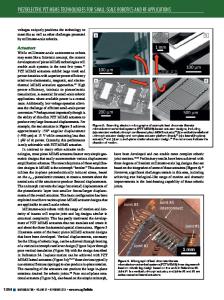Preparation of Piezoelectric PZT Thin Films by Mocvd for MEMS Applications
- PDF / 874,469 Bytes
- 7 Pages / 417.6 x 639 pts Page_size
- 86 Downloads / 318 Views
Mat. Res. Soc. Symp. Proc. Vol. 596
2000 M1etderIls Research Society
development, partly owing to related interests in ferroelectric capacitors for nonvolatile memory applications using thin film PZT. In this work, piezoelectric properties of thin film PZT prepared by a state-of-the-art MOCVD process were investigated [7]. Effects of Zr-to-Ti composition, preferred orientations, and film thickness were examined, and the results are presented. EXPERIMENT Film depositions were carried out in two CVD tools. Each tool features a warm-wall chamber and a temperature-controlled showerhead configured for 6-inch wafers. One of the tools was equipped with a loadlock and the process was tuned to deposit films of tetragonal compositions. The other tool did not possess a loadlock and the process was tuned to deposit films of compositions on either side of the MPB. Liquid metalorganic precursors with three constituent elements were mixed and flash vaporized using an ATMI liquid delivery system to produce the precursor gas stream. The use of liquid delivery enabled precise control of precursor solution mixing and therefore excellent composition control. Two sets of process conditions were used to produce films of different textures. These conditions are summarized in Table 1. Process A produced highly (100) textured films (type A), while process B produced films with less pronounced (100) texture. Representative XRD patterns are shown in Figure 1. Table I
Summary of MOCVD deposition conditions used in the present experiment: process A and process B. These two processes led to films of different textures. Process CVD tool
A with loadlock
570°C - 600 0 C
Substrate temperature
Zr/Ti ratio Film thickness
B without loadlock 550 0 C - 580°C
38/72
45/55 - 61/39
0.1 - 1.0 Vim
0.48 - 0.61 llm
Process A
Process B 0
0 0 Cl
20
30
40
50
60
20
20
30
40
50
60
20
Figure 1 Representative X-ray diffraction patterns of PZT films produced by process A and process B. The films produced by process exhibiting strong (100) texture, and the films by process B exhibited weak (100) texture.
542
The PZT films were characterized for composition, crystallinity, and morphology. Thickness and composition were measured with a Rigaku 3613 X-ray fluorescence (XRF) wafer analyzer with standards prepared by wet techniques. Crystallinity and texture were determined by X-ray diffractometry (XRD) using a Rigaku DMAX system in the Bragg-Brentano (0-20) geometry with CuK, radiation. For electrical characterization of select samples, Pt top electrodes were deposited by electronic beam evaporation through a shadow mask. Dielectric permittivity and loss tangent (tan 6) were measured at 10 kHz using a Hewlett-Packard HP 4192 impedance analyzer. Ferroelectric hysteresis was measured using a Radiant Technologies RT6000 ferroelectric tester. To facilitate the study of thickness and composition effects on piezoelectricity, films of various thickness and composition were deposited by process A and process B, respectively. The thickness and compositio
Data Loading...











